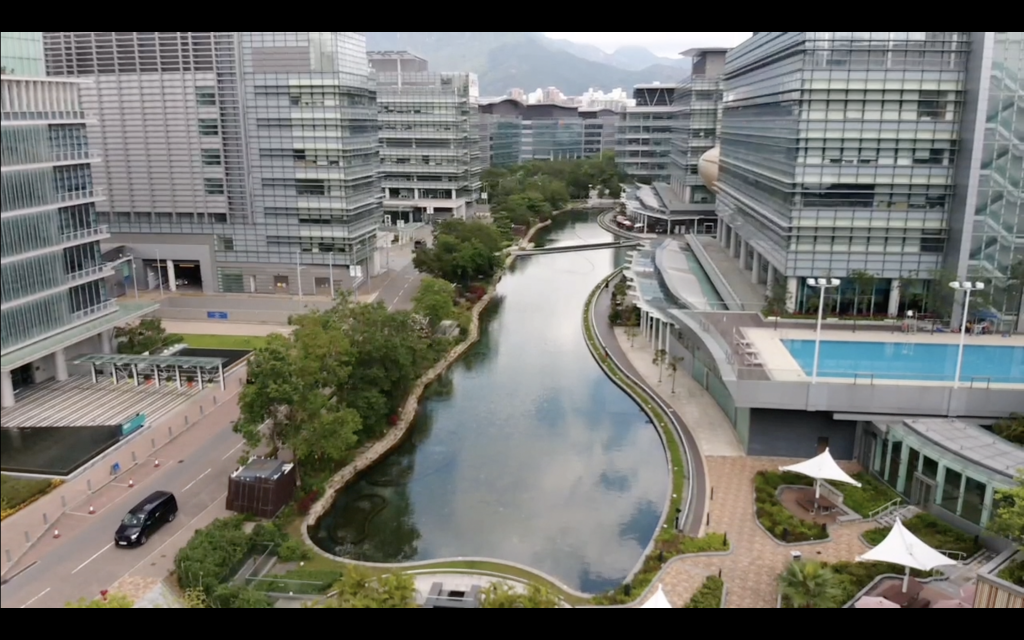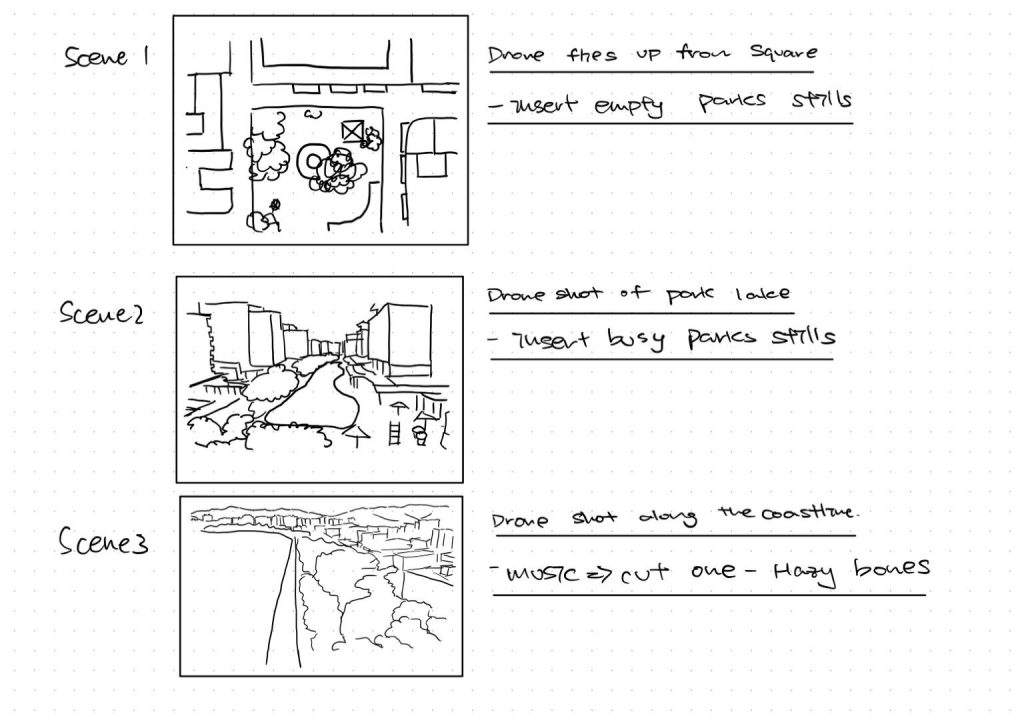
Story Board

Description
Parks have long been something of an anomaly in the cityscape, especially in one as densely urbanized as Hong Kong. This park in the heart of Tai Po market is a pretty accurate description of what these pocket parks all over Hong Kong look like-surrounded by buildings, motorways, walkways and the like. So, one might be misled to think that these parks might as well not exist, and that parks in general are simply taking up space that can be instead used build more housing, malls or offices to provide for the population. There was a push to repurpose country parks as housing land in 2019, and calls to remove urban parks due to their apparent uselessness have persisted throughout the years.
Then came the pandemic, and the leisure trips that Hong Kongers frequently took to Korea, Japan or Taiwan became things of the past. And with group activities outlawed by the government, parks, large and small, suddenly became the de facto choice for relaxation and exercise. Suddenly, people began taking camping trips to the islands, hikes in country parks, and walks in nearby parks. To many, myself included, the value of parks in cities suddenly became clear, asides from being natural air filters and serving as a relaxing agent for our eyes, it more importantly helps us maintain a healthy psyche. People who exercise in parks prompt others who see them to exercise, producing a positive feedback loop that can enlarge indefinitely. And in this time of distress and negativity, exercise is exceptionally important for people to maintain their mental and physical health. Parks provide the best venues for this.
I recall the fantasy cities from the early nineteen-hundreds, with their crisscrossing bridges, endless streams of traffic, and of course their sky-reaching buildings. These cities looked plainly ridiculous in the montages that were shown in the lectures, but if not for these few footholds humans have allowed nature to keep in their cities, Hong Kong is much more similar to those cities than I thought. This also has links to the mental issues I mentioned prior-only seeing urban features can lead to cognitive fatigue and stress, and parks can provide a restorative function in this regard. Parks bridge the gaps between urban features, hence the name, conjoined city.
Personally, visiting parks also invoked long-forgotten memories from my childhood, when I’d run out to parks to play with friends that I made there. Swings, merry-go-arounds, slides. How many children of today, I wonder, would choose to play on these seemingly antique devices instead of the virtual world, where the possibilities were all but endless?
That really got me thinking, if not for the pandemic, would I have realised the subtle role that parks have humbly played in the cities? And if it took a potentially civilisation-ending event to make me realise this, just how much else have I taken for granted all my life? A loving family, a comfortable life, good friends, and more? The pandemic has upheaved our way of life, and the price humanity has paid as a whole is heavy, but perhaps we can come out of the other side stronger and better.
Research and Construction:
First, I wanted to identify the role of parks in the city. I visited a variety of parks across Hong Kong. But one in Tai Po market struck a chord with me, where it was completely surrounded by buildings. I decided to use a drone to capture the effect of the encirclement. Then I observed a similar situation in Science Park, although the situation was slightly less cramped, the way the buildings surrounded the park was still apparent. By then, I’ve decided that I wanted to use the Parks as a metaphor for good things that we don’t appreciate, and that the co-existence of parks alongside urban features was crucial to the well-being of any given city. With this in mind, I flew my drone along Tai Po promenade Park, which borders an industrial area. I was able to capture the scene of nature next to artificial constructions, and used this as a basis to deliver my message at the end. I also read several articles on the importance of parks for humans, both on the physical and mental level, those are used in the description where I discussed the Park’s importance.
Video Production
The video consists of three main scenes. The first being the most extreme example of urban parks, the second being a more moderate demonstration, and the third showing co-existence of man and nature. In my initial discussion, I’ve also added in some stills of ‘parks’ to demonstrate the critical lack of greenery and the ridiculous measures that the city has taken to supplement it. In all three videos, the camera pans upwards towards the end, I tried do this consistently in order to demonstrate the difference is surroundings for the parks. The hopeful music used in the end also conveys my hope that I, and all of us can become better after the pandemic has shown us just how fragile we were before.
Music used:
Cut One-Hazy Bones
References:
Donaldson, W. (2015, September 1). Why Parks Are Important to Your Community. PerfectMind. https://blog.perfectmind.com/the-importance-of-local-parks
Hedblom, M., Gunnarsson, B., Iravani, B. et al. (2019). Reduction of physiological stress by urban green space in a multisensory virtual experiment. Scientific Reports 9, 10113 (2019). https://doi.org/10.1038/s41598-019-46099-7
Lo, A. (2019, December 12). Develop some Hong Kong country parks into public flats. /South China Morning Post./ https://www.scmp.com/comment/opinion/article/3041870/develop-some-hong-kong-country-parks-public-flats
Li Ming Chak
UID: 3035785570
This video is so so so well done! This may be the best video essay on parks I’ve seen (and that’s coming from a fellow student who also did her video on parks). Everything is so well executed — the prior research, the storyboard, the shots (so symmetrical that they’re like how these parks are supposed to be viewed), the architect’s narrative, the analysis of the changing relevance and purpose of parks before and during the pandemic, the detailed and efficient introduction of each individual park… It feels especially refreshing to be seeing an exploration of the topic from the perspective of utility, and where the location itself acts as the protagonist (which is the complete opposite of what I did: an exploration from an anthropologist angle, treating the park as a supporting role. It’s amazing how the exact same topic can be approached in such different ways.) Overall, I seriously enjoyed your video and learned so much from it. Keep up the good work!
It is really interesting to see that you investigate these places with so much thoughts and reflections, some of them very personal and authentic. And I agree with you that parks are very important for our mental health. We need to connect with nature from time to time to keep ourselves sane. Life would be so much harder if we are always looking at the urban city with its majestic and grand construction without a hint of nature. But I think the angles you use to look at the sidewalk can be more diverse? like looking at some details of the sidewalk, looking up from below, from different people’s perspective. Since you have mentioned your childhood and the compare it to that of the children nowadays, perhaps you can also look at the parks from the point of view of the children to see how it is like for them now? Cuz now I think you have made use of some angles which are taken from a very high angle, like from an aerial camera. But you are mainly looking at the park from one single angle. So I think you can try more angles to show different point of view.
The video demonstrated an understanding of and the ability to apply and synthesise research, concepts and key issues relating to a well-identified topic. You were able to adequately identify the most critical aspects of the theme/place and present a competently articulated analysis and interpretation of the topic. You maintained a good control of techniques and organisation of the form/content and narration; I appreciate the amount of aerial footage that you have shot. To further improve, it would be great if there are more observational clips or photos at ground level (a more human scale) to illustrate your vision as there is a slight disconnect between narration and visual towards the end of the video. The written and verbal articulation are of good academic standard, and adequately integrated into the overall presentation.